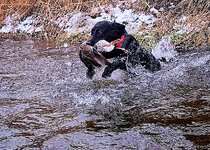I'm a Canon and Fuji APS-C user predominately, but the exact camera sort of doesn't matter. Regardless of the type of outdoor photography, my ideal setup is a fast prime (f1.2-f1.8) in the 35-50mm full frame equivalent range and a 70-200/2.8. That said, I've gotten good shots with less than ideal setups - often having somewhat intentionally handicapped myself.
I approach most outdoor photography sort of the same as I imagine a wedding photographer might approach a wedding ceremony and reception - you're telling a story that is occurring (usually) somewhere between 100 yards and less than a foot away. Meaning, you'll want to capture shots that are up close and shots that are somewhat far away so you will need a body and lens combo that can accommodate that.
I've taken a LOT of photos with a Canon 80D and a Tamron G2 70-200 - some even happen to be upland themed. A 70-200/2.8 (or equivalent if you are going with something other than a APS-C or full frame sensor body) with a constant aperture throughout the zoom range will give you good reach without sacrificing too much on the aperture speed and light gathering abilities which makes for nice subject isolation/background separation/shallow depth of field. This can be helpful to keep backgrounds of images from becoming too busy and detracting from whatever your subject may be while also letting you get more shots in at first and last light without raising your ISO to an unusable level.
70-200/2.8 and Canon 80D shots:
 IMG_8085
IMG_8085 by
chrisbrennerphoto, on Flickr
 IMG_8126
IMG_8126 by
chrisbrennerphoto, on Flickr
 IMG_9982
IMG_9982 by
chrisbrennerphoto, on Flickr
 Pheasant Hunting 12-21-2019
Pheasant Hunting 12-21-2019 by
chrisbrennerphoto, on Flickr
 IMG_6636
IMG_6636 by
chrisbrennerphoto, on Flickr
 IMG_7062
IMG_7062 by
chrisbrennerphoto, on Flickr
 IMG_8245
IMG_8245 by
chrisbrennerphoto, on Flickr
 IMG_8557
IMG_8557 by
chrisbrennerphoto, on Flickr
A fast prime - 35mm, 40mm or 50mm usually, in f1.2, f1.4 or f1.8 allows for even better low light performance at the sacrifice of reach, but is also really nice to help with that shallow depth of field for detail shots, close ups, etc. You can even use it at a bit longer distances to help blur things like foliage between you and your subject so the image is less distracting and it's clear what your subject is, as they are usually the only thing in focus. Some of these were taken on a 18-35mm/1.8 Sigma Art zoom lens, though it is effectively 3-5 prime lenses in one as just like the 70-200/2.8 the f1.8 aperture is consistent throughout the range, unlike a lot of other zoom lenses. The fast aperture is also helpful for being able to freeze motion with higher shutter speeds without sacrificing quality due to increased ISO and subsequent noise.
Fast prime shots, also all on a Canon 80D:
 Northwoods Grouse
Northwoods Grouse by
chrisbrennerphoto, on Flickr
 Northwoods Grouse
Northwoods Grouse by
chrisbrennerphoto, on Flickr
 Northwoods Grouse
Northwoods Grouse by
chrisbrennerphoto, on Flickr
 Northwoods Grouse
Northwoods Grouse by
chrisbrennerphoto, on Flickr
Like I said, though, you can get away with less than ideal equipment sometimes. On a few recent trips I have taken just my Fuji X100V which is a 35mm equivalent f2.0 fixed lens APS-C camera either due to flight/luggage constraints or just wanting something unobtrusive to throw over my shoulder and carry in the woods/mountains/wherever.
X100V shots:
 2024 Northwoods
2024 Northwoods by
chrisbrennerphoto, on Flickr
 2024 Northwoods
2024 Northwoods by
chrisbrennerphoto, on Flickr
 2024 Northwoods
2024 Northwoods by
chrisbrennerphoto, on Flickr
Bonus X100V non-upland:
 DSCF9287
DSCF9287 by
chrisbrennerphoto, on Flickr
 DSCF9835
DSCF9835 by
chrisbrennerphoto, on Flickr
 DSCF0018
DSCF0018 by
chrisbrennerphoto, on Flickr
 DSCF8990
DSCF8990 by
chrisbrennerphoto, on Flickr
Any digital camera body from Canon/Nikon/Fuji/Olympus/Sony from the past decade has the ability to take amazing photos - I would focus more on which lens mount family you find more useful and make your decision more around the lenses you will be using most often than the body itself. Just like hunting optics, camera lenses are worth putting more money into than the camera body and if you go with a newer body/mount (Canon RF, Nikon Z, Fuji X, Sony E, M43, etc.) then you'll have a lens collection that doesn't need to be upgraded with the body for quite some time.


























